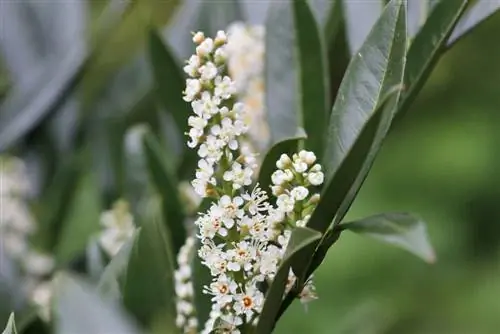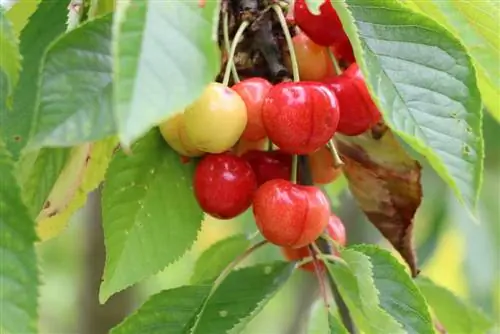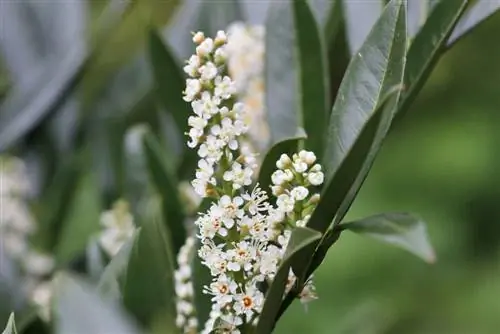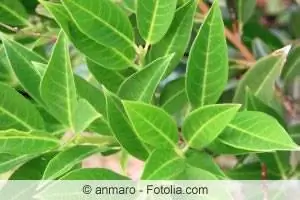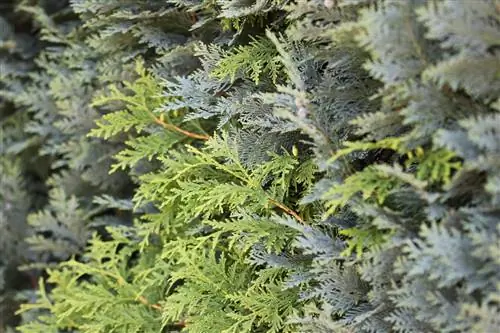- Author admin [email protected].
- Public 2023-12-17 03:39.
- Last modified 2025-01-24 12:45.
The cherry laurel is a shrub or tree that is ideal for hedge cultivation. The name laurel is misleading here because it is an evergreen plant from the plum and cherry family. Due to its inherent frost hardiness, it is very popular as a hedge in local latitudes. When is the right time to plant and how to ideally plant is explained in the following article.
Planting time autumn
Early autumn is the ideal planting time for container and bale goods, which are usually offered in garden shops. Because when the days get colder, the plants go into hibernation. They no longer sprout and no longer form buds or flowers. At this point they can put all their energy into the formation of new roots, which should have grown out of the ball by the start of winter and the first frost. When planting in autumn, the following should be taken into account:
- ideal is the beginning of September
- no frost expected yet
- Roots can spread easily
Especially because the evergreen shrubs evaporate water over their large leaf surfaces in winter, it is important that the roots have spread well before the first frost and can therefore absorb the water they need.
Tip:
Practice has shown that a newly planted or older cherry laurel has hardly any problems with the frost itself in winter and does not die of frostbite. It is much more common for plants to dry out in winter because they are not provided with enough water.
Planting time spring to summer
Bale or container goods are generally suitable for planting in spring and summer. Because the roots are already well developed here. This means that the plants can absorb nutrients immediately after planting and do not have to put all their energy into root formation. The hedge begins to sprout new shoots in the first year, which are then stable enough to survive the next winter until the first frost in autumn. Above all, the time for planting in spring and summer should be chosen as follows:
- waiting for the last frosty nights
- Ideal is in May after the Ice Saints
- don't plant too late in summer
- until June is the ideal time
- otherwise too many new shoots will no longer be hardy
Tip:
When buying cherry laurels, pay particular attention to the root balls. Because these indicate the quality of the plants purchased. If the quality is very high, the bale will not break when touched and can therefore be placed completely into the planting hole.
When to plant cuttings

The cherry laurel is also available in stores as bare root cuttings. Since you can propagate your own plants quite well using cuttings, you can also grow them yourself. In autumn the cuttings no longer sprout and can therefore put all their energy into root formation. It is ideal if these are placed in the ground in early autumn in September. If this point was missed, you should proceed as follows:
- cultivate in pots over the winter
- place in a frost-free place
- Cuttings can root so well
- keep cool and slightly dark
- plant outside in early spring
- choose a frost-free day
- add a thick layer of mulch over soil
- protects against frost
The time should be chosen so early in spring that the cuttings and bare-root plants from the trade have the opportunity to grow well before the first buds and leaves begin to sprout.
Tip:
If the cuttings are too warm and bright in winter, they may start to sprout. However, this activity hardly produces the necessary roots.
Planting spacing
When planting a cherry laurel hedge, you must pay particular attention to the correct planting distance. This is important so that the finished hedge later grows nice and dense, but the individual plants do not get in the way of each other and the hedge becomes bald. The young plants from the trade are usually between 40 centimeters and 60 centimeters high. The distance between the individual holes should be between 90 centimeters and 1.10 meters, even if the small plants make it look like the hedge is too far apart. However, the remaining gaps are growing quite quickly. When it comes to planting distance, the following should be taken into account:
- Cherry laurel is very small when planted
- tempts you to plant the plants closely
- full-grown plant grows up to three meters high
- Shoots also grow wider
- Cherry laurel grows very densely
- get bushy
- be sure to keep a distance of about one meter
Tip:
Even if the newly planted cherry laurel hedge looks very thin due to the large distance, next year after planting it will have grown well and holes will have already closed. Because the cherry laurel is a fast-growing plant when cared for properly.
Plants
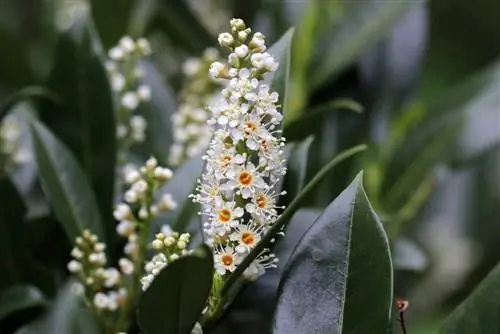
If the cherry laurel hedge is planted, there are other things to consider in addition to the planting distance. The plants cannot tolerate waterlogging, so drainage should be created. To do this, stones or gravel are placed on the bottom of each planting hole before the cherry laurel is inserted. This prevents water from accumulating on the roots, for example when it rains for a long time. When planting, the following should also be taken into account:
- deep and permeable soil
- prepare the soil if necessary
- Mix in compost
- possibly add sand or clay
- dig a big hole
- Root ball must have enough space
- Insert cherry laurel carefully
- dip the root ball in a water bath beforehand
- fill the hole with the prepared soil
- Tamp the soil well and water it
After planting, it is helpful to spread a layer of mulch around the plants to retain moisture in the soil. In addition, the young cherry laurel is supplied with additional nutrients.
Location
Cherry laurel is particularly popular for hedges because it can thrive in almost any location. It can thrive just as well in sunny places as in partially shaded and even predominantly shaded locations. It is suitable for the following locations in the garden:
- as a privacy screen from the neighboring property
- can also be in full sun
- also under trees
- as property demarcation from the street
- on a terrace as a privacy screen
The cherry laurel is not a good windbreak. Because of the great density of its leaves, the wind builds up behind the hedge and is pushed upwards. This means that the wind comes unhindered over the upper edge, so comfortable sitting in front of the hedge is not guaranteed. Therefore, when choosing the location for the hedge, you should pay particular attention to ensuring that it is not in a very drafty corner where a seat might be created.
Tip:
The only location that the cherry laurel cannot tolerate is in deep shade, for example on the north side of a house front or under very tall, dense trees.
Soil texture
The easy-care cherry laurel places few demands on the soil. It can be offered nutrient- and humus-rich clay soils as well as slightly dry, sandy soil. The pH value of the soil can also vary between alkaline and moderately acidic. The cherry laurel hedge is suitable for almost any soil in the garden and can be used as a privacy screen in many places. The following properties are also desired from the substrate of the cherry laurel:
- no waterlogging
- no compacted soil
- permeable soil is ideal
Tip:
On sandy soil, the cherry laurel becomes more frost-hardy because the new shoots become woody earlier in the fall and thus become more winter-hardy.
Differences when purchasing

Container or bale goods or rather bare root. There are differences when purchasing cherry laurel. The ideal planting time also depends on the product. But it's not just the timing that is an important point when making a decision; the quality of the goods can also vary greatly and so can the price. If the length of the hedge and the required planting distance are calculated in advance, it is easier to decide on one or the other product. The main features of different products are as follows:
- bare root plants are sold without soil
- are the cheapest goods
- useful for a very long cherry laurel hedge
- Bale goods are removed from the field with soil
- this is usually sold in an iron basket
- often also in linen cloth
- can be planted in the hole with soil, basket or cloth
- the purchase is medium priced
- container goods are expensive
- sold in pots with soil
Tip:
Even if container goods are the most expensive variant, they are usually the best quality when it comes to the roots. Because container goods are grown in the pot in which they are later sold. This means that roots were not damaged, as can be the case when cutting out the bale goods. In addition, container goods can be planted in the garden all year round.

